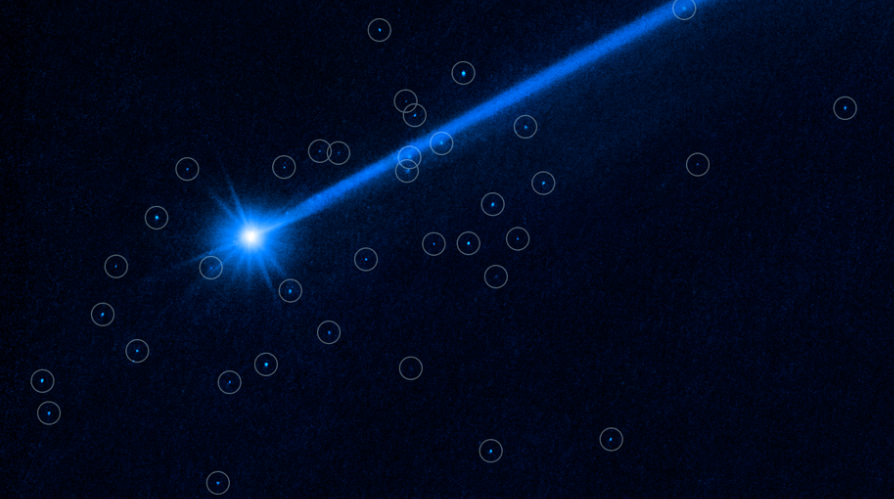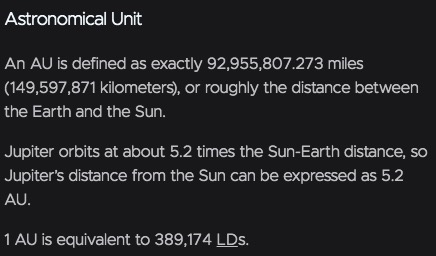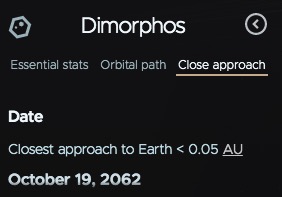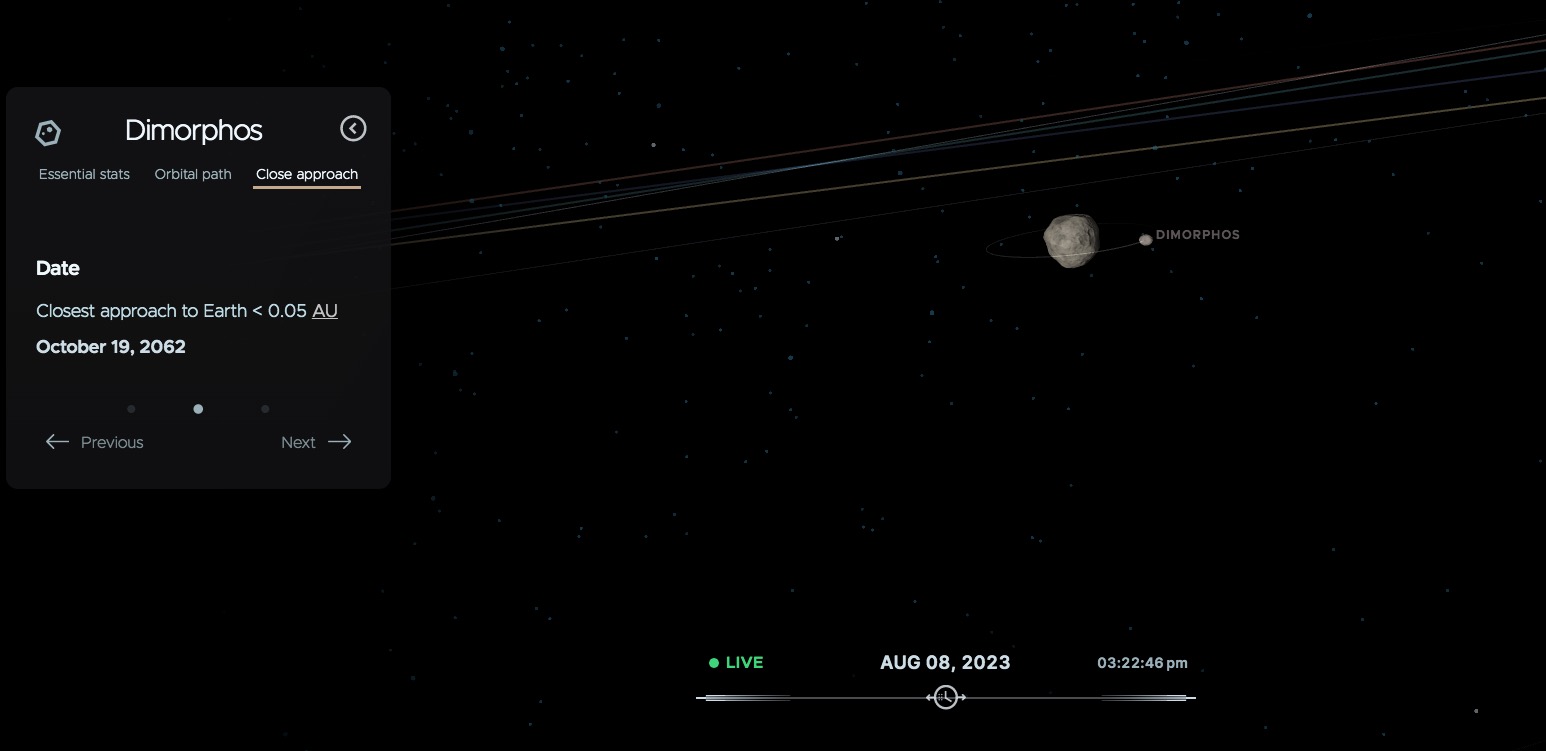It looks like you're using an Ad Blocker.
Please white-list or disable AboveTopSecret.com in your ad-blocking tool.
Thank you.
Some features of ATS will be disabled while you continue to use an ad-blocker.
share:
"WHAT IS THIS" you may ask...
This is a dire warning wrapped in the guise of "nothing to see here" science
I start by hoping that at least the majority of readers remembers the NASA "DART" project, for those who dont, you can read this article.
NASA Confirms DART Mission Impact Changed Asteroid’s Motion in Space
www.nasa.gov...
Here we are, almost 1 year later and we are not only learning more about the "planetary defence" impact missions affects on the Dimorphos asteroid but we are learning of its seemingly "unintended" effects
Hubble Sees Boulders Escaping from Asteroid Dimorphos

This is NASA saying they have no idea where these things are going...
While the next article may not be directly stating that the sky is falling, there is no certainty to our safety.
Planetary defense test deflected an asteroid but unleashed a boulder swarm
So, while this newly formed asteroid swarm is still 6 million miles away, Scientists have no idea which trajectory they are on.
Potentially 37 new hiroshima sized threats to humanity
We will have to wait until 2026 or longer for any confirmation on even an idea of where these things are going.
Thankfully we still have 2017 PDC to look forward to in 2027...
ASTEROID’S CHANCE OF EARTH IMPACT IN 2027 NOW 96%
But its only an "excercise"
We all know how these "exercises" work...
Totally coincidence that Dimorphos and Didymos are a binary system as described in the "excercise"
Just chance that NASA would try to to deflect this specific binary asteroid....
cneos.jpl.nasa.gov...
This is a dire warning wrapped in the guise of "nothing to see here" science
I start by hoping that at least the majority of readers remembers the NASA "DART" project, for those who dont, you can read this article.
NASA Confirms DART Mission Impact Changed Asteroid’s Motion in Space
www.nasa.gov...
Here we are, almost 1 year later and we are not only learning more about the "planetary defence" impact missions affects on the Dimorphos asteroid but we are learning of its seemingly "unintended" effects
Hubble Sees Boulders Escaping from Asteroid Dimorphos
Astronomers using Hubble's extraordinary sensitivity have discovered a swarm of boulders that were possibly shaken off the asteroid when NASA deliberately slammed the half-ton DART impactor spacecraft into Dimorphos at approximately 14,000 miles per hour.
The 37 free-flung boulders range in size from three feet to 22 feet across, based on Hubble photometry. They are drifting away from the asteroid at little more than a half-mile per hour – roughly the walking speed of a giant tortoise. The total mass in these detected boulders is about 0.1% the mass of Dimorphos

"This is a spectacular observation – much better than I expected. We see a cloud of boulders carrying mass and energy away from the impact target...
...The boulders are some of the faintest things ever imaged inside our solar system."
"If we follow the boulders in future Hubble observations, then we may have enough data to pin down the boulders' precise trajectories. And then we’ll see in which directions they were launched from the surface," said Jewitt.
This is NASA saying they have no idea where these things are going...
While the next article may not be directly stating that the sky is falling, there is no certainty to our safety.
Planetary defense test deflected an asteroid but unleashed a boulder swarm
A new study led by UCLA astronomer David Jewitt found that the collision had an unintended consequence: It launched a cloud of boulders from its surface. And, as the paper notes, smaller rocks flying off into space could create their own problems....
“Because those big boulders basically share the speed of the targeted asteroid, they’re capable of doing their own damage.”
Jewitt said that given the high speed of a typical impact, a 15-foot boulder hitting Earth would deliver as much energy as the atomic bomb that was dropped on Hiroshima.
So, while this newly formed asteroid swarm is still 6 million miles away, Scientists have no idea which trajectory they are on.
Potentially 37 new hiroshima sized threats to humanity
We will have to wait until 2026 or longer for any confirmation on even an idea of where these things are going.
The European Space Agency’s HERA spacecraft will have an opportunity to collect more data about the boulders when it returns to Dimorphos in 2026 to study DART’s results in more detail.
Thankfully we still have 2017 PDC to look forward to in 2027...
ASTEROID’S CHANCE OF EARTH IMPACT IN 2027 NOW 96%
But its only an "excercise"
We all know how these "exercises" work...
Totally coincidence that Dimorphos and Didymos are a binary system as described in the "excercise"
Just chance that NASA would try to to deflect this specific binary asteroid....
cneos.jpl.nasa.gov...
edit on 08pm31100000023 by datguy because: (no reason given)
a reply to: ByteChanger
we wont know until the HERA mission arrives in 2026, i dont think there was a civ on the rock but i could be wrong.
They think most of the objects were thrown from the impact crater and will use the further explorations to determine but the impact could have release loose materials from any where on the rock, not just the crater.
a reply to: DAVID64

we wont know until the HERA mission arrives in 2026, i dont think there was a civ on the rock but i could be wrong.
They think most of the objects were thrown from the impact crater and will use the further explorations to determine but the impact could have release loose materials from any where on the rock, not just the crater.
a reply to: DAVID64

That's pretty good news. It's good that they were able to determine the outcome so well and create only minor debris, ranging from only 3 feet to
about 22 feet.
Any object entering the Earth's atmosphere, depending on its density and makeup (and speed), would burn up unless it was over around 25 meters, or about 82 feet in diameter.
These 3 to 22 foot pieces are mere pebbles and stand no chance of surviving entry. They would further break down into smaller pieces as soon as they hit our atmosphere, and then smaller pieces would break up and burn up as well. Some material from that 22 foot chunk may make it down and ruin some roofs, but most of that material would come down as dust.
If they can sustain this work, this looks promising as a planetary defense effort.
Any object entering the Earth's atmosphere, depending on its density and makeup (and speed), would burn up unless it was over around 25 meters, or about 82 feet in diameter.
These 3 to 22 foot pieces are mere pebbles and stand no chance of surviving entry. They would further break down into smaller pieces as soon as they hit our atmosphere, and then smaller pieces would break up and burn up as well. Some material from that 22 foot chunk may make it down and ruin some roofs, but most of that material would come down as dust.
If they can sustain this work, this looks promising as a planetary defense effort.
originally posted by: Mahogany
That's pretty good news. It's good that they were able to determine the outcome so well and create only minor debris, ranging from only 3 feet to about 22 feet.
Any object entering the Earth's atmosphere, depending on its density and makeup (and speed), would burn up unless it was over around 25 meters, or about 82 feet in diameter.
These 3 to 22 foot pieces are mere pebbles and stand no chance of surviving entry. They would further break down into smaller pieces as soon as they hit our atmosphere, and then smaller pieces would break up and burn up as well. Some material from that 22 foot chunk may make it down and ruin some roofs, but most of that material would come down as dust.
If they can sustain this work, this looks promising as a planetary defense effort.
Even then that's only if it transits Earth's orbit or the boulders somehow get deflected in the next 38 years, right now the closest Earth approach is in 2062 when it's.05 AU away
solarsystem.nasa.gov...



edit on 8-8-2023 by putnam6 because: (no reason given)
Well if it wasn't fictional at least it may hit China. Solve a lot of issues. Hopefully not Japan!
The question is, are the fragments separation speed faster then the astroids escape velocity? If not, they will eventually fall back onto the asteroid
or in this case possibly it's companion. Even if they have enough velocity, they are not just drifting around. They are following orbits just slightly
different than the asteroid but affected by the gravity of the pair.
Kind of a swarm around the original object but staying with it.
Tha mission was not that succsfull in my opinion other than proving that object is just a clump of rocks. Unlike hitting a ball with a bat it was more like hitting a clump of dirt with a bat. Much less predictable outcome and makes a big mess instead of redirecting the object.
Kind of a swarm around the original object but staying with it.
Tha mission was not that succsfull in my opinion other than proving that object is just a clump of rocks. Unlike hitting a ball with a bat it was more like hitting a clump of dirt with a bat. Much less predictable outcome and makes a big mess instead of redirecting the object.
a reply to: beyondknowledge2
valid point
I was hoping that it (DART) wouldn't do any damage upon impact, proving that it wasnt just a ball of ice and dirt, the fact is we really have no idea what these objects are made of. Hopefully when HERA makes its pass we can get some info on composition, dirt/metal/ice/all of the above.
We should find a way to ignite Didymos and observe the rest of the debris to see if it forms a mini solar system
valid point
I was hoping that it (DART) wouldn't do any damage upon impact, proving that it wasnt just a ball of ice and dirt, the fact is we really have no idea what these objects are made of. Hopefully when HERA makes its pass we can get some info on composition, dirt/metal/ice/all of the above.
We should find a way to ignite Didymos and observe the rest of the debris to see if it forms a mini solar system
🫤 shooting space rocks with nukes is really boring and expensive, im more concerned about g gangstas stealing cigarettes, lap tops from hell, and
cartel assholes than I am worried about getting obliterated by space rocks. Bring on the rock apocalypse.
a reply to: datguy
Give me a lever long enough and a fulcrum on which to place it, and I shall move the world. ~Archimedes
I have heard it apply to mountains as well.
Since space has circular orbits(Heian era mathematical theory) no matter how small example; Ring formations and orbits... The consequences of; DART could be dire; In keeping with the OP's theme; Which and wherein should be a world effort not a single country or office to hold as responsible. In case the porn is accurate and the cause of actual doooom or just a massive change to adjust to.
Give me a lever long enough and a fulcrum on which to place it, and I shall move the world. ~Archimedes
I have heard it apply to mountains as well.
Since space has circular orbits(Heian era mathematical theory) no matter how small example; Ring formations and orbits... The consequences of; DART could be dire; In keeping with the OP's theme; Which and wherein should be a world effort not a single country or office to hold as responsible. In case the porn is accurate and the cause of actual doooom or just a massive change to adjust to.
edit on 8-8-2023 by Crowfoot because: sp
originally posted by: datguy
Thankfully we still have 2017 PDC to look forward to in 2027...
You know this is a "hypothetical" asteroid....?
cneos.jpl.nasa.gov...
A hypothetical asteroid impact scenario will be presented at the 2017 IAA Planetary Defense Conference (PDC), to be held in Tokyo, Japan, May 15-19, 2017. Although this scenario is realistic in many ways, it is completely fictional and does NOT describe an actual potential asteroid impact. The scenario is as follows: An asteroid is discovered on March 6, 2017, at magnitude 21.1, and confirmed the following day. It is assigned the designation “2017 PDC” by the Minor Planet Center. (To reinforce the fact that this is not a real asteroid, we are using three letters in the designation, something that would never be done for an actual asteroid.)
I hope you didn't sell all your treasures to go live in the woods just yet....
"This is a spectacular observation – much better than I expected. We see a cloud of boulders carrying mass and energy away from the impact target...
...The boulders are some of the faintest things ever imaged inside our solar system."
Sounds(reads) like, "us" considering... How small, "we" are theorized(said) to be; In what has been... A continuing volume of intelligence of; Known and yet to be known titled: *Universe.
*Including all abstracts of theory hypothesis or not in tow as entertainment and debate in order to "grow".
That's not what your source says in the sentence after the one you quoted, bolded for emphasis:
originally posted by: datguy
This is NASA saying they have no idea where these things are going...
While the next article may not be directly stating that the sky is falling, there is no certainty to our safety.
Planetary defense test deflected an asteroid but unleashed a boulder swarm
"Jewitt said that given the high speed of a typical impact, a 15-foot boulder hitting Earth would deliver as much energy as the atomic bomb that was dropped on Hiroshima."
So, while this newly formed asteroid swarm is still 6 million miles away, Scientists have no idea which trajectory they are on.
Jewitt said that given the high speed of a typical impact, a 15-foot boulder hitting Earth would deliver as much energy as the atomic bomb that was dropped on Hiroshima.
Fortunately, neither Dimorphos nor the boulder swarm have ever posed any danger to Earth. NASA chose Dimorphos because it was about 6 million miles from Earth and measured just 581 feet across — close enough to be of interest and small enough, engineers reasoned, that the half-ton Double Asteroid Redirection Test, or DART, planetary defense spacecraft would be able to change the asteroid’s trajectory.
So they know enough about the trajectories to say they don't pose a danger to Earth.
Also the Hiroshima bomb exploded fairly close to the ground. When a similar bomb explodes high in the atmosphere it's not really going to have much effect on the ground. so those boulders that aren't headed toward earth, if they were headed toward Earth, would probably make a nuclear sized explosion high in the atmosphere. In the Chelyabinsk incident, a 59 foot diameter rock exploded in the atmosphere with the energy of about 30 Hiroshima sized bombs. It broke some windows, causing some broken glass injuries, but I don't think anybody died.
So the nuclear sized explosion only equal to one Hiroshima bomb from a 15 foot boulder would be 30 times smaller than that; not the best doom porn even if it was headed for Earth.
edit on 202389 by Arbitrageur because: clarification
a reply to: Arbitrageur
Heres whats interesting about diff sized hydrogen ones it vaporizes and can be diameter controlled then it disappears.
The atomic that is not in the blast and flash zone(think microwave oven) that inverts: night and day perceptions climbing instead of digging etc a rather large bounce... against our planetary well of spin that it is in.
Heres whats interesting about diff sized hydrogen ones it vaporizes and can be diameter controlled then it disappears.
The atomic that is not in the blast and flash zone(think microwave oven) that inverts: night and day perceptions climbing instead of digging etc a rather large bounce... against our planetary well of spin that it is in.
edit on 9-8-2023 by Crowfoot because: clarity/sp.
a reply to: datguy
the much more costly yet sensible thing to do would be to capture them and bring them to rest
and leave them somewhere where we can go and mine them later, instead of smacking them off a collision course with earth, as there is no real way of knowing where they will end up
place them in a Lagrange point or something and we can go harvest them later
if we can land a small drone on the asteroid /meteor
then surely with a swarm of drones landing with thrusters we can eventually steer them into position
the drones also deploy a mesh around the entire thing wich prevents chunks from blasting off into space
much like we put metal nets on cliff faces near roads.
I get that it would be expensive but the returns in mineral wealth from these things could outweight the initial costs
and also it would remove the desire to plunder the earth for natural minerals.
Its far off in the future of course, but Im pretty sure the technology exists right now to achieve this.
it would take a global effort from space industry to achieve but would be better for us on earth
less pollution from strip mining the earth.
it would be incredibly expensive but transferring industry off world into space
would be great , earth could get back to being a lovely blue green planet
the much more costly yet sensible thing to do would be to capture them and bring them to rest
and leave them somewhere where we can go and mine them later, instead of smacking them off a collision course with earth, as there is no real way of knowing where they will end up
place them in a Lagrange point or something and we can go harvest them later
if we can land a small drone on the asteroid /meteor
then surely with a swarm of drones landing with thrusters we can eventually steer them into position
the drones also deploy a mesh around the entire thing wich prevents chunks from blasting off into space
much like we put metal nets on cliff faces near roads.
I get that it would be expensive but the returns in mineral wealth from these things could outweight the initial costs
and also it would remove the desire to plunder the earth for natural minerals.
Its far off in the future of course, but Im pretty sure the technology exists right now to achieve this.
it would take a global effort from space industry to achieve but would be better for us on earth
less pollution from strip mining the earth.
it would be incredibly expensive but transferring industry off world into space
would be great , earth could get back to being a lovely blue green planet
a reply to: Arbitrageur
the quoted comment is also not in regards to Dimorphos or Didymos but rather the "debris" that is the topic of the article.
From the same article, second to last paragraph,
Also bolded for emphasis
the quoted comment is also not in regards to Dimorphos or Didymos but rather the "debris" that is the topic of the article.
From the same article, second to last paragraph,
“If we follow the boulders in future Hubble observations, we may have enough data to pin down the boulders’ precise trajectories,” Jewitt said.“And then we’ll see in which directions they were launched from the surface and figure out exactly how they were ejected.”
Also bolded for emphasis
also with regards to space junk and defunct orbital satellites
instead of letting them fall to earth and burn up wasting valuable materials
they could build a space recycling plant on the ISS which sends out small drones to harvest the material bring them back to the ISS for processing
allowing the scientists up there to have access to materials
to make things in space
imagine they had a furnace to smelt the material up there and allow them access to materials to build a bigger station
would be so cool if they could fabricate parts in space
would save so much money
instead of letting them fall to earth and burn up wasting valuable materials
they could build a space recycling plant on the ISS which sends out small drones to harvest the material bring them back to the ISS for processing
allowing the scientists up there to have access to materials
to make things in space
imagine they had a furnace to smelt the material up there and allow them access to materials to build a bigger station
would be so cool if they could fabricate parts in space
would save so much money
a reply to: sapien82
we will get there eventually, there are already companies and nations seeking mining rights and ownership of many parts of the solar system.
I think the biggest issue will be establishing the infrastructure to launch/capture/mine/transport.
I feel like establishing an orbital platform or a base on the moon is the first step and I have to wonder though how long that will take.
Bringing the materials back to earth will be a whole new obstacle once we gain the ability to acquire them. As things stand now I just don't see any feasibility in the endeavour.
a reply to: sapien82
i also think utilizing the materials already in space, instead of wasting them and letting them burn would be very beneficial to these efforts
we will get there eventually, there are already companies and nations seeking mining rights and ownership of many parts of the solar system.
I think the biggest issue will be establishing the infrastructure to launch/capture/mine/transport.
I feel like establishing an orbital platform or a base on the moon is the first step and I have to wonder though how long that will take.
Bringing the materials back to earth will be a whole new obstacle once we gain the ability to acquire them. As things stand now I just don't see any feasibility in the endeavour.
a reply to: sapien82
i also think utilizing the materials already in space, instead of wasting them and letting them burn would be very beneficial to these efforts
edit on 09am31900000023 by datguy because: (no reason given)
new topics
-
Just learned a really helpful trick for internet searches
Computer Help: 29 minutes ago -
Not off to a good start
General Chit Chat: 2 hours ago -
If they can see...they can read!!
Rant: 9 hours ago
top topics
-
Tesla Cybertruck Explodes in Front of Trump Hotel in Las Vegas
Mainstream News: 14 hours ago, 19 flags -
If they can see...they can read!!
Rant: 9 hours ago, 7 flags -
Maybe they didn't get away with it: The Lincoln-Kennedy assassination parallels. 7 sentences long.
History: 17 hours ago, 4 flags -
Not off to a good start
General Chit Chat: 2 hours ago, 2 flags -
Just learned a really helpful trick for internet searches
Computer Help: 29 minutes ago, 0 flags
active topics
-
The C.D.C. Says There Was NO INFLUENZA Worth Reporting for the 2020-2021 Flu Season.
Diseases and Pandemics • 88 • : network dude -
If they can see...they can read!!
Rant • 12 • : Flyingclaydisk -
Just learned a really helpful trick for internet searches
Computer Help • 0 • : Flyingclaydisk -
Vehicle Strikes people in New Orleans
Mainstream News • 247 • : xWorldxGonexMadx -
Not off to a good start
General Chit Chat • 3 • : billxam1 -
DONALD J. TRUMP - TIME's Most Extraordinary Person of the Year 2024.
Mainstream News • 43 • : Imhere -
How we've changed in 100 years
Ancient & Lost Civilizations • 19 • : Flyingclaydisk -
Tesla Cybertruck Explodes in Front of Trump Hotel in Las Vegas
Mainstream News • 58 • : Flyingclaydisk -
Mood Music Part VI
Music • 3774 • : Hellmutt -
SCOTUS Chief Justice JOHN ROBERTS Ends 2024 Describing His Fears for Safety of U.S. Judges.
Above Politics • 11 • : WeMustCare

